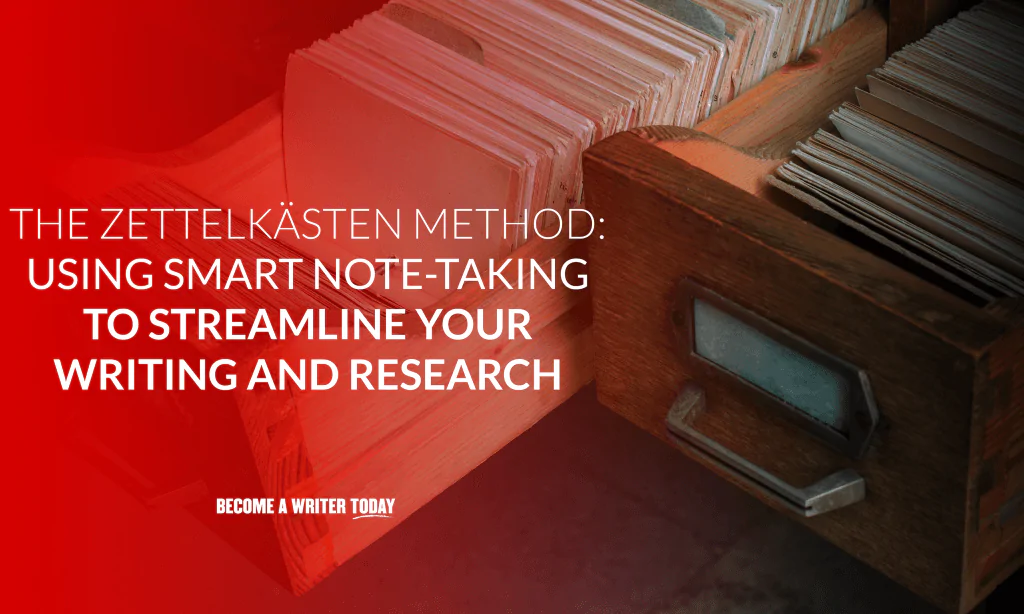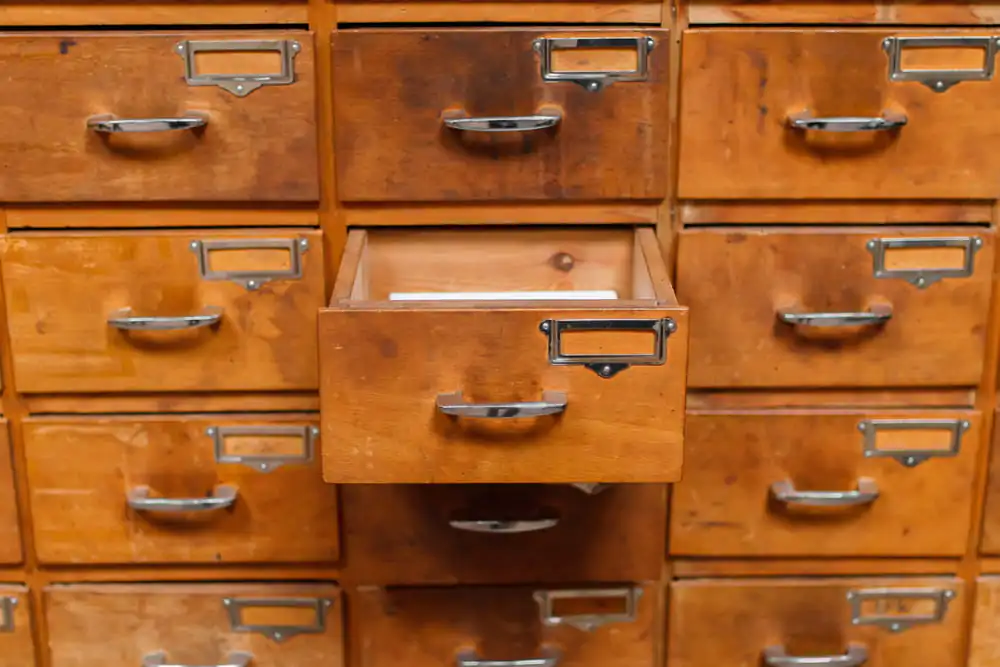The Zettelkästen Method of note-taking can transform your workflow as a writer.
Productive writers all tend to have one thing in common: they know how to take good notes. If you are the type of person who did not enjoy taking notes in high school and disregarded them altogether in college, then it may be time to re-learn the skill. The Zettelkästen Method, also called a slipbox, may be a way to do it.
The word “Zettelkästen ” is a German word. Literally translated it means “note box.” This method came from sociologist Niklas Luhmann who used a literal zettelkästen to take, organize and keep notes throughout his lifetime.
With that zettelkästen, Luhmann was able to publish 70 books and 500 articles over 30 years. That is a tremendous amount of writing, and all of his writing was on research-heavy topics. Here is a closer look at the Zettelkästen Method and how you can use it to help you categorize and link ideas.
If you want to set up your own note-taking system for your writing, I created just the thing. Click here to learn more.
Contents
- What Is the Zettelkästen Method?
- Linking Ideas Within the Zettelkästen
- References And Cross-References
- Note Card Types in the Zettelkästen Method
- The Modern Zettelkästen System
- Apps that Make the Zettelkästen System Work for the Modern Writer
- The Final Word on the Zettelkästen Method
- FAQs About the Zettelkästen Method
- Resources
What Is the Zettelkästen Method?

What made Luhmann’s note-taking method unique was not the fact that he wrote over 90,000 notecards, though that number is impressive. Rather, it is the way he categorized those notecards. Many have come to call this system the “atomic notecard” system because of the way it powerfully organizes knowledge to create a research workflow.
When Luhmann came across a new idea in his reading and research that he wanted to add to his database, he would write it on a physical notecard. If that idea was a completely new one, it would get its own number or letter category to enter into the slip box. As he researched further and found additional ideas to add to his notecards, he would add notes, linking them to the notes they connect to using more letters and numbers, such as:
- 1/1: Card with the original topic
- 1/1a: Card connected to an idea on the original topic
- 1/1b: Additional thoughts on 1/1a
- 1/1b1: More notes connecting to 1/1b1
This system can continue indefinitely, connecting ideas and adding new sub-ideas under the original ideas.
Linking Ideas Within the Zettelkästen
One feature that made Luhmann’s note-taking system unique was his ability to link ideas. Not only did he number the note cards to show how they related to the note cards before them, but he also added references, or links, to the note cards that connected them to other parts of the file system.
Thus, when researching a particular idea, the note card he would pull would have links to other cards within the zettelkästen that have related research. He could constantly add new notes to the cards to link to various areas of his system, keeping his research organized at all times.
Many historians credit Luhmann’s linking system with the development of the modern hyperlink. Today, researchers don’t have to use note cards in a file box, but instead they can link their ideas electronically, but the basic idea of this process comes from Luhmann’s work.
References And Cross-References
A key to a successful Zettelkästen is references and cross-references. Not only do you need to work references into your note-taking method to connect your ideas back to the original source, but cross-references through links will also help when you use your own zettelkästen for research. It becomes more than just individual notes, but rather an interconnecting lattice of ideas that help with knowledge management.
Note Card Types in the Zettelkästen Method
In addition to the linking and filing method used, Luhmann developed a unique notecard-taking method. He had three types of note cards in his system. These include:
- Literature notes: Literature notes are the notes you grab while reading or researching. When you come across an idea that is of potential interest, write an index card that indicates where the idea was found. Write the note in your own words.
- Fleeting notes: Fleeting notes are the notes you jot down when an idea comes to you. Keep paper and pencil on hand at all times, or use an app like Evernote, so your ideas are never lost.
- Permanent note: The permanent note takes the literature notes and fleeting notes and adds them to the filing system, with the links and references in place.
Each note card needs to include a note that you will understand both now and in the future, written in your own words and properly connected to reference material.
The Modern Zettelkästen System
So how can the filing system of a German sociologist from the 1950s help the modern writer and researcher? Technology gives you the ability to make a zettelkästen of your own, without the cumbersome notecard making and filing process.

Where in Luhmann’s zettelkästen note cards were linked using a somewhat complex numbered and lettered system, in the modern zettelkästen you can use hyperlinks and keywords to link ideas. Each note card still gets a unique identifier, often a number, and a link to the reference, but the internal linking system is much more intuitive.
In many ways, Wikipedia can be viewed as a giant zettelkästen. Each Wikipedia page is its own Zettel “notecard,” and the links within the pages connect that Zettel to other ideas. Annotations at the end of each page link to the original reference.
Apps that Make the Zettelkästen System Work for the Modern Writer
If the Zettelkästen Method is intriguing to you, consider investing in an app to create your own digital zettelkasten. Some that work well include:
- Obsidian Notes: Obsidian organizes your notes into a knowledge graph, linking ideas and keeping you organized.
- TiddlyWiki: This wiki model app is a free and open-source option to let you create your own Zettel.
- RemNote: This app is described as a thinking and learning workspace that helps you organize your ideas through bullet point notes and graphic organizers.
- The Archive: The Archive provides a note-taking program that organizes your notes into a zettel-style archive.
- Roam Research: This note-taking tool organizes your thoughts into a networked database.
The Final Word on the Zettelkästen Method
Today, the Zettelkästen Method is still in use, but it exchanges notecards and slips of paper for hashtags and apps, but it still remains a great tool to organize information. For many people, it becomes like a second brain, helping them keep their research and ideas straight until they are ready to write.
Though an analog Zettelkästen may be too cumbersome for the modern writer, a digital one can help organize ideas so they are easily found again. By carefully taking notes and plugging in the backlinks to other notes, you can have a workable filing system that will make your research and writing processes easier.
FAQs About the Zettelkästen Method
What Is The Best Way To Organize Notecards In The Zettelkästen Method?
The best organizational structure is one that makes sense to the person using the Zettelkästen, but it is often not a pure alphabetic filing system. Keywords, hashtags and tags can help connect linked ideas to each other and across the system to create an interconnected web.
What Is A Smart Note?
Smart notes are notes designed to fit into a Zettelkästen system, with hyperlinks and related notes connected to the original piece of information.
Resources
Listen to our podcast about the Zettelkasten method.

